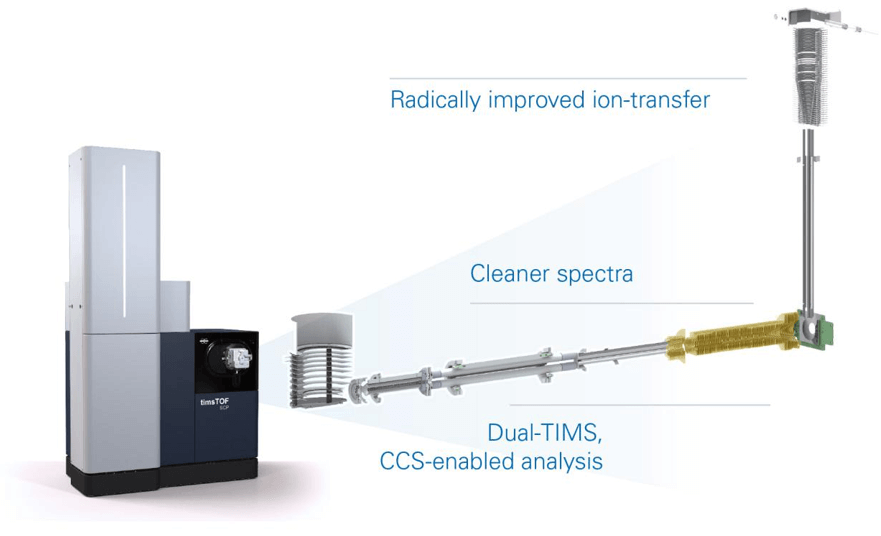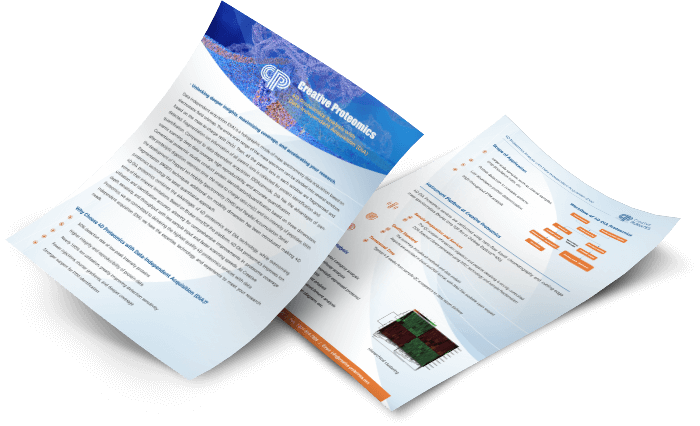4D Proteomics Services
The basic principle of mass spectrometry proteomics is to analyze the physical and chemical properties of ions of the tested sample, and obtain qualitative and quantitative results according to the mass spectrum of the sample. At present, proteomics mass spectrometry is generally based on the three dimensions of retention time (retention time), mass-to-charge ratio (m/z), and ionic strength (intensity) to identify and quantify peptide proteins, that is, 3D proteomics.
4D proteomics adds a fourth dimension, ion mobility, on top of 3D proteomics, which mainly separates ions based on the shape and cross-section of the ions, and can distinguish peptides with very small m/z, so that low-abundance protein signals can be distinguished and identified. 4D proteomics is based on the timsTOF Pro mass spectrometer, allows repeated measurement of the collision cross-section (CCS) of all detected ions for proteome characterization and quantification with broader coverage, better reproducibility, and faster acquisition speed.
 timsTOF Pro mass spectrometer
timsTOF Pro mass spectrometer
Our 4D Proteomics Services:
Based on timsTOF Pro, we have launched 4D proteomics services, including 4D Label-free, 4D-DIA, 4D phosphorylation, and other 4D post-translational modification services to help research in microsample proteomics, large cohort clinical samples, and high-throughput PTMomics (post-translational modification omics).
4D-DIA Quantitative Proteomics Service
Based on timsTOFPro, it has high scanning speed and high sensitivity, while reducing the complexity of the spectrum and improving the ion utilization rate.
4D Label-Free Proteomics Service
The accuracy and the depth of identification, the accuracy of quantification, and the detection cycle have been greatly improved, and the sample size requirements have been greatly reduced.
4D-PTMs Proteomics Service
4D label-free PTMs Proteomics is based on the new generation of timsTOFPro mass spectrometer, which can effectively distinguish modified isomeric peptides and greatly improve the depth of modification identification, with the advantages of less loading volume and faster scanning speed.
4D-Glycosylation Proteomics Services
Our new generation 4D platform with higher identification depth and more accurate site analysis. All O-GlcNAc sites and glycoforms are analyzed and can be combined with phosphorylation to achieve a one-stop analysis
4D-LFQ Metaproteomics Services
Creative Proteomics provides you with cutting-edge protein 4D-LFQ metaproteomics services for biomarker validation, clinical and industrial applications. 4D-LFQ can the complexity of sample pre-processing and improves the stability of sizeable clinical cohort samples.
Data Analysis
| Standard Data Analysis Content |
| Mass spectrometry data analysis | Spectral peptide quality deviation distribution, peptide length distribution, unique peptide number distribution, protein coverage distribution |
| Quantitative Protein Analysis | Protein abundance value distribution, protein abundance ratio distribution between samples, PCA analysis, statistical analysis of significant differences |
| Protein Functional Analysis | Total protein and differential protein GO secondary classification, COG function classification, KEGG annotation, subcellular organelle location, domain annotation, signal peptide prediction and PPI prediction; differential protein GO, KEGG, domain enrichment analysis |
| Advanced Data Analysis Content |
| Protein Gene Chromosome Localization | Obtain the distribution of genes encoding proteins on chromosomes |
| WGCNA Analysis | Predict functional clustering and network interactions by protein expression level; correlate with phenotype data to obtain key proteins or protein complexes that influence phenotype |
| Trend Cluster Analysis | Obtain protein expression trend patterns |
| Molecular Typing | Molecular typing for large cohort samples |
| Survival Curve Analysis | Study the relationship between influencing factors and survival time and outcome |
| ROC Curves | Evaluate predictive accuracy by combining specificity and sensitivity, such as biomarker impact assessment on tumor grade |
Technical Advantages:
- Supported by 4D technology, more suitable for small samples
- Overcome the limitation of labeled quantitative proteomics technology in the number of samples
- More flexible and convenient
- Using timsTOFPro mass spectrometry platform, the detection speed is nearly doubled
Sample Requirements:
- Co-IP Samples: Protein requirement is around 2-5ug, do not include decontaminants (e.g. SDS) and high oxygen concentration in the sent protein samples; or you can send the beads containing protein samples to us directly and we will take care of the subsequent experiments.
- Tissue Samples: Please send us the tissue samples on dry ice.
| Tissue Samples | Protein | # of Cells | Animal Tissue | Plant Tissue | Blood | Urine | Serum | Microbes |
| Quantify | 100 ug | 1×107 cells | >200 mg | 1 g | 1 mL | 2 mL | 0.2-0.5 mL | Dry weighed: 200 mg |
- Protein Samples: Please make sure the total amount of protein is above 50ug; ordinary tissue and cell lysate can be used for protein extraction.
- Transportation: Please use sufficient amount of dry ice for transportation and try to use a fast postal delivery method to reduce the possibility of sample degradation during transportation.
Report:
- Experimental steps
- Relevant experimental parameters
- Mass spectrometry spectra
- Raw data
- Proteomics analysis results
* For Research Use Only. Not for use in the treatment or diagnosis of disease.

 timsTOF Pro mass spectrometer
timsTOF Pro mass spectrometer
 4D Proteomics with Data-Independent Acquisition (DIA)
4D Proteomics with Data-Independent Acquisition (DIA)